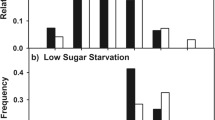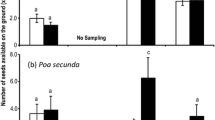Summary
Food-sharing experiments were performed with laboratory colonies of Solenopsis invicta containing 1000, 10,000, or 20,000 workers and starved for 0, 3, 7, or 14 days. The effect of these variables was measured on the uptake of radioactive sugar water (1 M) by 1% of the colony's workers and on the trophallactic flow of food from these foragers to the remainder of the colony.
Patterns of food distribution in small colonies differed significantly from those in larger nests. In 1000-ant nests, small workers more frequently received food than large workers, but in bigger colonies the opposite occurred.
Fire ants were adept at distributing sugar water, with food from a few workers rapidly reaching the majority of the colony as foragers donate their crop contents to groups of recipients and these recipients may themselves act as donors.
Foragers respond to colony starvation by individually taking up more food and sharing this fluid with a greater proportion of nestmates. Even foragers from satiated colonies can retrieve at least small amounts of liquid.
The forager's state of hunger plays an important role in regulating food distribution. In sugar-satiated nests, previously starved foragers are highly successful at passing on labelled sugar whereas prviously fed foragers are not.
Similar content being viewed by others
References
Abbott A (1978) Nutrient dynamics of ants. In: Brian MV (ed) Production ecology of ants and termites. Cambridge University Press, Cambridge, England, pp 233–244
Eisner T, Brown WL Jr (1958) The evolution and social significance of the ant proventriculus. Proc 10th Int Congr Entomol 2:503–508
Eisner T, Wilson EO (1958) Radioactive tracer studies on liquid food transmission in ants. Proc 10th Int Congr Entomol 2:509–513
Glancey BM, Stringer CE Jr, Craig CH, Bishop PM, Markin GP (1973) Evidence of a replete caste in the fire ant, Solenopsis invicta. Ann Entomol Soc Am 66:233–234
Gösswald K, Kloft W (1960) Neuere Untersuchungen über die sozialen Wechselbeziehungen im Ameisenvolk, durchgeführt mit Radioisotopen. Zool Beitr 5:519–556
Gösswald K, Kloft W (1963) Tracer experiments on food exchange in ants and termites. In: Proceedings of a symposium of the International Atomic Energy Agency, Vienna: Radiation and radioisotopes applied to insects of agricultural importance. International Publications. New York, pp 25–42
Hays SB, Hays KL (1959) Food habits of Solenopsis saevissima richteri. J Econ Entomol 52:455–457
Kneitz G (1963) Tracerversuche zur Futterverteilung bei Waldameisen. In: Symposia Genetica et Biologica Italica. Ati del IV Congresso dell' U.I.E.I.S., vol 12. Tipographia del Libro SAS, Pavia, pp 38–50
Lenoir A (1974) Les relations trophallactiques au sein des jeunes societés de Lasius niger L. (Hymenoptères Formicidae). CR Hebd Seances Acad Sci [Ser D] 279:1781–1784
Markin GP (1970) Food distribution within laboratory colonies of the Argentine ant, Iridomyrmex humilis Mays. Insectes Soc 17:127–158
Markin GP, Dillier JH, Collins HC (1973) Growth and development of colonies of the red imported fire ant, Solenopsis invicta. Ann Entomol Soc Am 66:803–808
Naarman H (1963) Untersuchungen über Bildung und Weitergabe von Drüsensekreten bei Formica (Hymenoptera: Formicidae) mit Hilfe der radio-isotopen Methode. Experientia 19:412–413
O'Neal J, Markin GP (1973) Brood nutrition and parental relationships of the imported fire and Solenopsis invicta. J Ga Entomol Soc 8:294–303
Petralia RS, Vinson SB (1978) Feeding in the larvae of the imported fire ant, Solenopsis invicta: Behavior and morphological adaptations. Ann Entomol Soc Am 71:643–648
Schneider P (1966) Versuche zur Frage der Futterverteilung und Wasseraufnahme bei Formica polyctena (Forst). Insectes Soc 13:297–304
Schneider P (1972) Versuche zur Frage der individuellen Futterverteilung bei der kleinen roten Waldameise (Formica polyctena Foerst). Insectes Soc 19:279–299
Sudd JH (1957) Communication and recruitment in Pharaoh's Ant, Monomorium pharaonis. Br J Anim Behav 3:104–109
Sudd JH (1967) The traffic in food. In: An introduction to the behavior of ants. St. Martins Press, New York, pp 114–135
Toom PM, Cupp, E., Johnson CP, Griffin I (1976) Utilization of body reserves for minim brood development by queens of the imported fire ant, Solenopsis invicta. J Insect Physiol 22: 217–220
Vinson SR (1968) The distribution of an oil, carbohydrate, and protein food source to members of the imported fire ant colony. J Econ Entomol 61:712–714
Wallis DI (1961) Food-sharing behaviour of the ants Formica sanguinea and Formica fusca. Behaviour 17:17–47
Wallis DI (1962) The relation between hunger, activity, and worker function in an ant colony. Proc Zool Soc (London) 139:589–605
Wallis DI (1964) The foraging behaviors of the ant, Formica fusca. Behaviour 23:149–175
Wilson EO (1962) Chemical communication among workers of the fire ant Solenopsis saevissima (Fr. Smith). I. The organization of mass-foraging. Anim Behav 10:134–147
Wilson EO (1971) The insect societies. Belknap Press of Harvard University Press, Cambridge
Wilson EO (1978) Division of labor in fire ants based on physical castes. J Kans Entomol Soc 51:615–636
Wilson EO, Eisner T (1957) Quantitative studies of liquid food transmission in ants. Insectes Soc 4:157–166
Wilson NL, Oliver AD (1969) Food habits of the imported fire ant in pasture and pine forest areas in southeastern Louisiana. J Econ Entomol 62:1268–1271
Author information
Authors and Affiliations
Rights and permissions
About this article
Cite this article
Howard, D.F., Tschinkel, W.R. The effect of colony size and starvation on food flow in the fire ant, Solenopsis invicta (Hymenoptera: Formicidae). Behav Ecol Sociobiol 7, 293–300 (1980). https://doi.org/10.1007/BF00300670
Received:
Accepted:
Issue Date:
DOI: https://doi.org/10.1007/BF00300670




